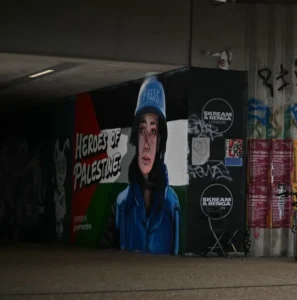UK Jewish creatives write guidance on antisemitism and censorship in arts

Graffiti by street artist Ed Hicks depicting a Palestinian journalist in photo taken on 30 January 2024
Middle East Eye reports on 7 May 2025:
Dozens of UK-based Jewish artists and creatives have published guidelines to help cultural institutions navigate issues surrounding antisemitism.
The text, titled ‘Courage and Care: Guidelines on confronting antisemitism and censorship in the arts’, was endorsed on Tuesday by more than 70 Jewish signatories.
“This text is designed as a resource to help institutions, organisations and individuals make better, braver decisions whilst contending with antisemitism and censorship in the arts,” the guidelines state. “It is written from a firm belief that art must be allowed to be political, subversive, uncomfortable – and that bigotry should be challenged.”
The first section outlines what antisemitism in the arts might look like, including workplace discrimination, abuse, problematic representation and tropes, and the minimisation of persecution, such as the Holocaust.
The next section outlines what the signatories say antisemitism in the arts does not look like. “We are united in believing that art must not be censored under a false guise of protecting against antisemitism,” it states. Examples of what isn’t antisemitism include artwork that criticises Israel or Zionism as a political force, and supporting the Palestinian struggle for freedom and self-determination.
“Palestinian symbols such as the Palestinian flag, Keffiyeh, a watermelon, and phrases such as ‘from the river to the sea, Palestine will be free’ are not in themselves antisemitic and should not be censored or banned,” the guidance says. It also adds that criticising or satirising the actions of specific Jewish people, as long as their Jewishness is not presented as an explanation of their vices, is not antisemitic.
The final section of the guidance presents “grey areas”, in which there can be ambiguity.
